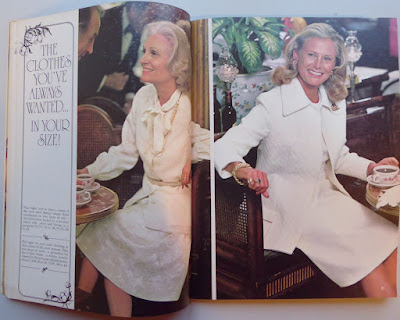Since I posted about older women and sewing. Time to recify that.
I always enjoy reading Susan Young's excellent blog, but her
latest post is particularly interesting. As some readers may know, Sue is involved with SewOver50, an online group which was initially set up to challenge the invisibility of older women in the online sewing world. Four years later, the group is thriving, both online with the
@SewOver 50 Instagram account and in real life with meetups, but Sue asks the question - has representation of older sewists by pattern companies actually changed in this time?
The answers are mixed. Some brands have definitely made the effort to be more age-inclusive in the images they use. Others, however, have a firmly 'youthful' aesthetic and are sticking to it - despite being happy to use the expertise of older sewists in pattern testing, their websites don't include any pictures of these aged and therefore off-brand testers wearing their creations!
Most of the comments, both on Sue's blogpost and the SewOver50 IG post are about modern Big4 and indie patterns (although
The Vogue Woman patterns from the 1990s do get an honourable mention), so mean very little to me, but seen from a vintage point of view, it does seem as though things are actually getting worse.
I've posted before about
half-size patterns. They were designed for the older figure: shorter, and with a lower bust point and wider waist than standard patterns. I had a few half-size patterns at the time I wrote the post, but have since acquired more. My oldest one dates from 1946, but most of them are from the 1960s and 1970s. The concept of half sizes doesn't seem to have lasted into the 1980s and, among the Big4 at least, Misses sizing now reigns supreme.
 |
| Simplicity 1749, 1946 |
 |
| Simplicity 4489, 1953 |
I assume that the sizing information section in pattern books provided an explanation of how half-sizes differed from other patterns, because there is usually no information on the pattern envelopes themselves. Butterick 9765 uses the
familiar trope of grey hair with a youthful face to indicate an older wearer, but then so does Butterick 9796, which is a Misses size.
 |
| Butterick 9765 and 9796, both 1961 |
Simplicity's 'Slenderette' line ran for several years, and included both half-size and Miss patterns. The illustrations don't show any obvious difference in body shape.
 |
| Simplicity 3758 and 3789, both 1960 |
Half-size patterns may have been intended for more mature figures, but that didn't always mean more conservative styles.
 |
| Short skirts in 1968, Simplicity 7696 |
By 1970 Simplicity were describing half-sizes on the pattern envelope as being for shorter women. Only by comparing the standard measurements with those of a Miss pattern does the more generous waist fitting become apparent.
 |
| Simplicity 8890 and 9003, both 1970 |
 |
| Standard body measurements on 8890 (top) and 9003 |
Style seems to have taken a different approach. The earliest half-size Style pattern I have dates from 1972. (Obviously, this doesn't prove that there were no half-size patterns any earlier, but I have a number of 1950s and 1960s Style patterns, and none of them are half sizes.) Before expanding into half-sizes, Style did appear to show older women on the pattern envelopes more often than other brands. This was not achieved by drawing older faces, but instead with more mature figures.
 |
| Different ages on Style patterns |
When Style did finally expand into half sizes, the older women vanished from the envelope artwork.
 |
| Style 3675, 1972 |
I don't have any Vogue half-size patterns, but what I have acquired since 2019 are the remaining 1975 issues of Vogue Patterns. For several issues in 1975 and early 1976
Vogue Patterns ran a feature called
"The Clothes You've Always Wanted . . . In Your Size". The same design was offered as two separate patterns, one in standard sizes and one in half sizes. When I
first posted about this, I didn’t have the Spring, Summer, and Early Autumn 1975 issues, but now I do. There is nothing in the Summer issue, but the other two follow the example of Early Spring issue by showing the clothes on an older model. Scandalous, I know.
 |
| Vogue Patterns, Spring 1975 |
 |
| The second (and final) double-page spread of the feature |
 |
| Early Autumn 1975 |
 |
| Older women looking stylish - who knew? |
 |
| And longer hair as well - shocking! |
It's depressing to think that almost 50 years we are struggling to get even that level of representation of older women. But on the other hand, it's been done before (and clearly didn't drive Vogue patterns into bankruptcy!) so can be done again.















No comments:
Post a Comment